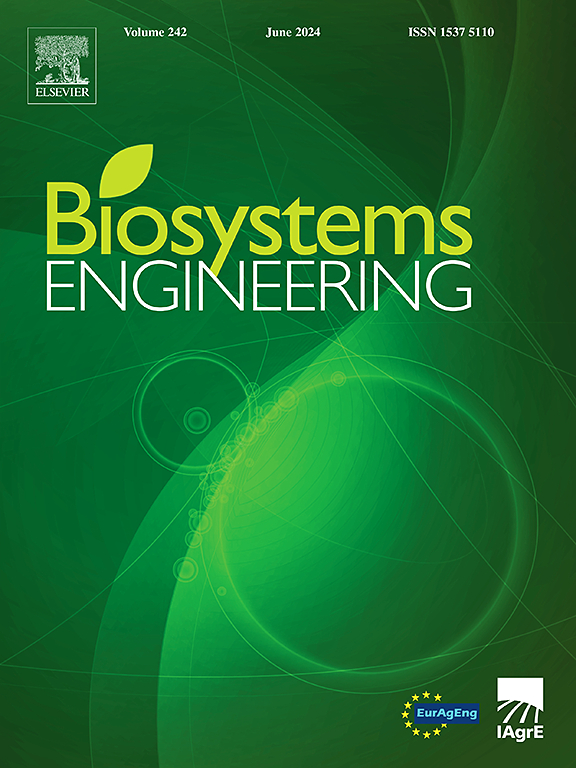A detailed plant model in CFD that resolves the microclimate around individual leaves
IF 4.4
1区 农林科学
Q1 AGRICULTURAL ENGINEERING
引用次数: 0
Abstract
Plant factories require effective ventilation to promote proper plant growth. Computational Fluid Dynamics (CFD) is commonly used to evaluate ventilation strategies in these environments. Traditionally, porous models have been employed to study ventilation in plant factories. However, this study proposes an alternative approach using actual plant geometry, consisting of leaves and stems, which reduces the need for fitting parameters typically used in porous models. The study focuses on basil, with plant geometry based on experimental data to ensure accurate representation. This new plant model accounts for the heat and mass balance of each leaf, assigning individual temperature and humidity values. Radiative heat exchange was also included in the plant model by using the solar ray tracing algorithm to solve for shortwave radiation and the surface to surface radiation model for longwave thermal radiation. Validation was conducted in a small plant factory-like environment (1500 mm × 420 mm x 800 mm) under night-like conditions without shortwave radiation and day-like conditions, with shortwave radiation. Key variables such as transpiration rate and leaf temperature were measured and simulated. The coefficient of variation between measured and simulated transpiration rates ranged from 10 % to 15 % for night-time and 15 % for day-time. Root mean square deviations for leaf temperature were 0.4–0.6 °C at night and 0.5–1.6 °C during the day. A different test case, with air supplied from the bottom instead of the side, demonstrated the new model's capabilities. Overall, the new plant model visualises airflow around and through the canopy, and shows promise for improving ventilation strategies in vertical farming systems.
一个详细的CFD植物模型,解决了单个叶片周围的小气候
植物工厂需要有效的通风来促进植物的正常生长。计算流体动力学(CFD)通常用于评估这些环境中的通风策略。传统上,多孔模型被用来研究植物工厂的通风。然而,本研究提出了一种替代方法,使用实际的植物几何结构,包括叶子和茎,这减少了对多孔模型中通常使用的拟合参数的需求。本研究以罗勒为研究对象,采用基于实验数据的植物几何结构来确保准确表征。这种新的植物模型考虑了每片叶子的热量和质量平衡,分配了单独的温度和湿度值。采用太阳射线追迹算法求解短波辐射,采用面对面辐射模型求解长波热辐射,将辐射换热纳入植物模型。验证在小型植物工厂环境(1500 mm × 420 mm × 800 mm)中进行,在类似夜间的条件下无短波辐射,在类似白天的条件下有短波辐射。对蒸腾速率和叶温等关键变量进行了测量和模拟。实测蒸腾速率和模拟蒸腾速率之间的变异系数在夜间为10%至15%,在白天为15%。叶片温度的均方根偏差夜间为0.4 ~ 0.6°C,白天为0.5 ~ 1.6°C。在另一个测试案例中,空气从底部而不是侧面供应,展示了新车型的性能。总的来说,新的植物模型可视化了树冠周围和通过树冠的气流,并显示了在垂直农业系统中改善通风策略的希望。
本文章由计算机程序翻译,如有差异,请以英文原文为准。
求助全文
约1分钟内获得全文
求助全文
来源期刊

Biosystems Engineering
农林科学-农业工程
CiteScore
10.60
自引率
7.80%
发文量
239
审稿时长
53 days
期刊介绍:
Biosystems Engineering publishes research in engineering and the physical sciences that represent advances in understanding or modelling of the performance of biological systems for sustainable developments in land use and the environment, agriculture and amenity, bioproduction processes and the food chain. The subject matter of the journal reflects the wide range and interdisciplinary nature of research in engineering for biological systems.
 求助内容:
求助内容: 应助结果提醒方式:
应助结果提醒方式:


